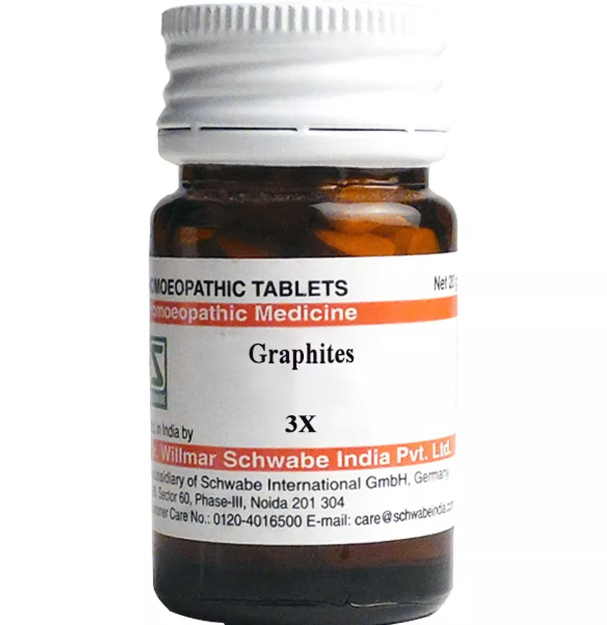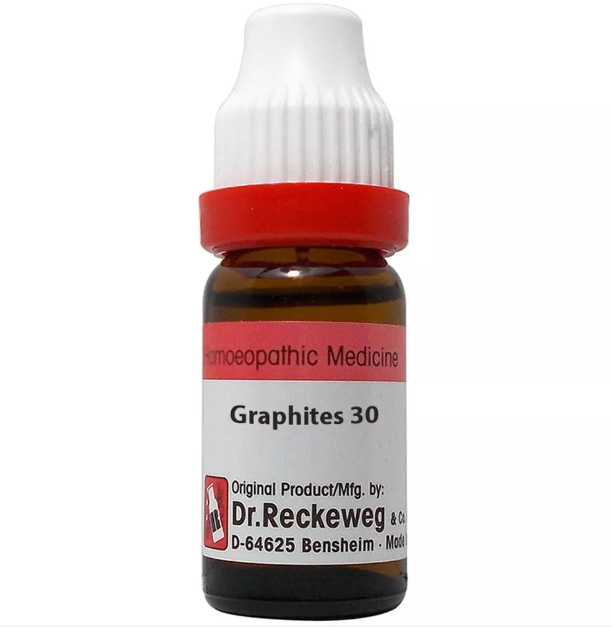GRAPHITES 3x, 6C, 12C, 30C, 200C, 1M, 10M USES AND SYMPTOMS
 GRAPHITES
GRAPHITES
(Black Lead, Plumbago)
Like all carbons, this remedy is a powerful anti-psoric, especially effective for stout patients with fair complexion, prone to skin issues and constipation, fat, chilly, and costive, with delayed menstrual history, and easily catch colds. Children are impudent, teasing, and laugh at reprimands. It tends to develop the skin phase of internal disorders and eradicates erysipelas tendencies. It addresses anemia with facial redness, obesity, swollen genitals, gushing leucorrhea, aids absorption of cicatricial tissue, induration of tissue, pyloric cancer, and duodenal ulcer.
Mind: Great tendency to start, timid, unable to decide, lack of desire to work, fidgety while sitting at work. Music makes her weep. Apprehensive, despondent, indecisive.
Head: Rush of blood to the head with a flushed face and epistaxis, distention and flatulence. Morning headache, mostly on one side, with a tendency to vomit (migraine). Sensation of a cobweb on the forehead, feels numb and pithy. Rheumatic pains on one side of the head, extending to teeth and neck. Burning on the vertex. Humid, itchy scalp eruptions emitting a fetid odor. Cataleptic condition.
Eyes: Ophthalmia with intolerance to artificial light. Eyelids red and swollen. Blepharitis. Dryness and fissures of the lids. Eczema of lids.
Ears: Dry inner ear. Cracking in ears when eating. Moisture and eruptions behind the ears. Hears better in noise. Hardness of hearing, hissing, and detonation in the ears. A thin, white, scaly membrane covers the membrana tympani like exfoliated epithelium. Fissures in and behind the ear.
Nose: Sore when blowing; painful internally. Abnormally acute smell; intolerant of flowers. Scabs and fissures in nostrils.
Face: Feels like cobwebs on it. Eczema of the nose. Itching pimples. Moist eczema around the mouth and chin. Erysipelas, burning, and stinging.
Mouth: Rotten odor. Breath smells like urine. Burning blisters on the tongue, salivation (aphthae), sour eructations.
Stomach: Aversion to meat. Sweets nauseate. Hot drinks disagree. Nausea and vomiting after meals. Morning sickness during menstruation. Stomach pressure and burning, causing hunger. Difficult eructations. Constrictive pain, recurrent gastralgia, flatulence. Pain temporarily relieved by eating, hot drinks, especially milk, and lying down.
Abdomen: Nauseous feeling, fullness, and hardness from incarcerated flatulence; must loosen clothing; presses painfully at the abdominal ring. Croaking in the abdomen. Sensitive, swollen inguinal region (inguinal hernia). Flatulent colic, opposite the lying side. Chronic diarrhea, brownish, liquid, undigested, offensive stools. Very fetid gas precedes colic.
Rectum: Constipation; large, difficult, knotty stools united by mucus threads. Burning hemorrhoids. Prolapse, diarrhea; brownish, fluid stools mixed with undigested substances, very fetid, sour odor. Smarting, sore anus, itching. Lumpy stool conjoined with threads of mucus. Varices of the rectum. Fissure in the anus.
Urinary: Turbid, with sediment, sour-smelling urine.
Male: Sexual debility with increased desire; aversion to coition; too early or no ejaculation; herpetic eruption on organs.
Female: Menses too late, with constipation; pale and scanty, with tearing epigastric pains and itching. Hoarseness, coryza, cough, sweats, and morning sickness during menstruation. Pale, thin, profuse, white, excoriating leucorrhea with great back weakness. Swollen, hard mammae. Induration of ovaries, uterus, and mammae. Sore, cracked, and blistered nipples. Decided aversion to coitus.
Respiratory: Chest constriction, spasmodic asthma, suffocative attacks waking from sleep; must eat something. Mid-chest pain with cough, scraping, and soreness. Chronic hoarseness with skin affections. Inability to control vocal cords, hoarseness on beginning to sing, and breaking voice.
Extremities: Pain in the nape of the neck, shoulders, back, and limbs. Spinal pains. Lumbosacral pain with great weakness. Excoriation between thighs. Numb left hand; arms fall asleep; thick, black, rough, inflamed fingernails. Edema of lower limbs. Crippled toe nails. Stiff, contracted toes. Brittle, crumbling, deformed, painful nails. Cracks or fissures in fingertips. Offensive foot sweat.
Skin: Rough, hard, persistently dry areas unaffected by eczema. Early keloid and fibroma stages. Pimples and acne. Sticky exudation from eruptions. Rawness in limb bends, groins, neck, behind ears. Unhealthy skin; every little injury suppurates. Glutinous, thin, sticky fluid from ulcers. Swollen and indurated glands. Gouty nodosities. Cracks in nipples, mouth, toes, anus. Phlegmonous erysipelas of the face; burning, stinging pain. Swollen feet. Wens. Chronic Poison oak.
Modalities: Worse with warmth, at night, during, and after menstruation. Better in the dark, from wrapping up.
Relationship: Complementary: Arg-n. (follows well in gastric derangements); Caust., Hep., Lyc., Ars., Tub. Compare: Petr., Sep., Sulph., Fl-ac. Associated constipation with mucus-covered stools and flatulence should be considered to differentiate it from remedies like Petr. and Lyc. (Raue). Antidote: Nux-v., Acon., Ars.

SYMPTOMS OF GRAPHITES
Mind:
Tendency to start easily
Timid and indecisive
Lack of desire to work
Fidgety while sitting at work
Weeping from music
Apprehensive, despondent
Head:
Rush of blood to the head, flushed face, epistaxis
Distention and flatulence
Morning headache, one-sided, with inclination to vomit (migraine)
Sensation of cobweb on the forehead, numb and pithy feeling
Rheumatic pains extending to teeth and neck
Burning sensation on the vertex
Humid, itchy scalp eruptions with fetid odor
Cataleptic condition
Eyes:
Ophthalmia with intolerance to artificial light
Red, swollen eyelids
Blepharitis
Dry and fissured lids
Eczema of the lids
Ears:
Dry inner ear
Cracking sounds when eating
Moisture and eruptions behind the ears
Better hearing in noise
Hardness of hearing, hissing, and detonation
Thin, white, scaly membrane on membrana tympani
Fissures in and behind the ear
Nose:
Painful internally when blowing
Abnormally acute smell, intolerant of flowers
Scabs and fissures in nostrils
Face:
Sensation of cobwebs
Eczema of the nose
Itching pimples
Moist eczema around the mouth and chin
Burning and stinging erysipelas
Mouth:
Rotten odor
Breath smells like urine
Burning blisters on the tongue
Salivation (aphthae)
Sour eructations
Stomach:
Aversion to meat
Nausea from sweets
Discomfort from hot drinks
Nausea and vomiting after meals
Morning sickness during menstruation
Stomach pressure and burning
Hunger from burning sensation
Difficult eructations
Constrictive pain, recurrent gastralgia
Flatulence, pain relieved by eating, hot drinks, especially milk, and lying down
Abdomen:
Nauseous feeling
Fullness and hardness from incarcerated flatulence
Painful pressure at the abdominal ring
Croaking sounds
Sensitive, swollen inguinal region (inguinal hernia)
Flatulent colic opposite the lying side
Chronic diarrhea, brownish, liquid, undigested, offensive stools
Very fetid gas
Rectum:
Constipation; large, difficult, knotty stools united by mucus threads
Burning hemorrhoids
Prolapse, diarrhea; brownish, fluid stools mixed with undigested substances, very fetid, sour odor
Smarting, sore anus, itching
Lumpy stool conjoined with threads of mucus
Varices of the rectum
Fissure in the anus
Urinary:
Turbid urine with sediment
Sour-smelling urine
Male:
Sexual debility with increased desire
Aversion to coition
Too early or no ejaculation
Herpetic eruption on organs
Female:
Late menses with constipation
Pale, scanty menses with tearing epigastric pains and itching
Hoarseness, coryza, cough, sweats, and morning sickness during menstruation
Pale, thin, profuse, white, excoriating leucorrhea with back weakness
Swollen, hard mammae
Induration of ovaries, uterus, and mammae
Sore, cracked, and blistered nipples
Aversion to coitus
Respiratory:
Chest constriction
Spasmodic asthma, suffocative attacks waking from sleep, needing to eat something
Mid-chest pain with cough, scraping, and soreness
Chronic hoarseness with skin affections
Inability to control vocal cords, hoarseness on beginning to sing, and breaking voice
Extremities:
Pain in nape of neck, shoulders, back, and limbs
Spinal pains
Lumbosacral pain with great weakness
Excoriation between thighs
Numb left hand, arms fall asleep
Thick, black, rough, inflamed fingernails
Edema of lower limbs
Crippled toenails
Stiff, contracted toes
Brittle, crumbling, deformed, painful nails
Cracks or fissures in fingertips
Offensive foot sweat
Skin:
Rough, hard, persistently dry areas unaffected by eczema
Early stages of keloid and fibroma
Pimples and acne
Sticky exudation from eruptions
Rawness in limb bends, groins, neck, behind ears
Unhealthy skin; every injury suppurates
Glutinous, thin, sticky fluid from ulcers
Swollen and indurated glands
Gouty nodosities
Cracks in nipples, mouth, toes, anus
Phlegmonous erysipelas of the face; burning, stinging pain
Swollen feet
Wens
Chronic Poison oak
Modalities:
Worse with warmth, at night, during, and after menstruation
Better in the dark, from wrapping up
selection of the potency
Individualization:
- Homeopathy is based on the principle of treating the individual, not just the disease. The unique symptoms and characteristics of the person are crucial in determining the most suitable potency.
Intensity of Symptoms:
- The intensity of the symptoms guides the choice of potency. If the symptoms are intense and acute, a lower potency (e.g., 6C, 30C) might be considered. For chronic conditions with less intensity, higher potencies (e.g., 200C, 1M) may be appropriate.
Sensitivity of the Patient:
- Some individuals are more sensitive to homeopathic remedies, while others may require higher potencies. The practitioner considers the patient’s sensitivity when selecting the potency.
Acute vs. Chronic Conditions:
- Lower potencies are often used for acute conditions, while higher potencies may be considered for chronic or long-standing issues.
Previous Response to Potencies:
- The patient’s response to previous homeopathic treatments helps guide the choice of potency. If a particular potency has been effective in the past, it may be repeated or adjusted as needed.
Vital Force and Susceptibility:
- Homeopathy views illness as a disturbance in the vital force. The practitioner assesses the patient’s overall vitality and susceptibility to determine the appropriate potency.
Aggravation or Amelioration:
- The direction of the symptom response (aggravation or amelioration) after taking a remedy can influence the choice of potency.
Miasmatic Considerations:
- In classical homeopathy, the concept of miasms (inherited disease tendencies) is considered. The practitioner take this into account when selecting the potency.
Practitioner Experience:
- The experience and preference of the homeopathic practitioner play a role. Some practitioners may have success with certain potencies based on their clinical experience.
SAFETY INFORMATION
- Do not exceed the recommended dose by physician
- Keep out of the reach of children
- Store in a cool dry place away from direct sunlight
- Maintain half an hour gap between food/drink/any other medicines and homoeopathic medicine
- Avoid any strong smell in the mouth while taking medicine e.g. camphor, garlic, onion, coffee, hing
Medicine images use for reference only selection of homeopathic medicine depends on the individual’s specific symptoms and overall constitution. Moreover, homeopathy is a holistic system of medicine that treats the individual as a whole. In addition to addressing the physical symptoms, it takes into account the emotional and mental state of the person. Consequently, it’s crucial to consult with a qualified homeopathic practitioner for personalized treatment.
The information provided on this website is intended solely for educational purposes. Always seek the advice of your physician or other qualified health provider.
